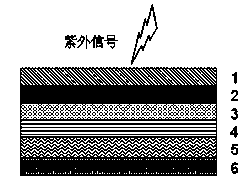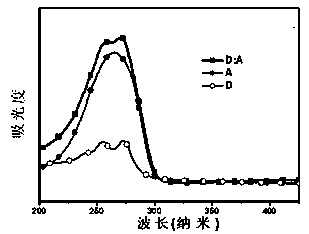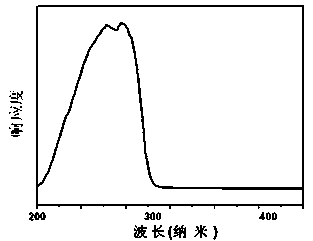Organic-inorganic composite day-blind type ultraviolet light detector
An inorganic composite and ultraviolet light technology, applied in the field of detectors, can solve the problems of unfavorable devices working for a long time and increasing the probability of contact
- Summary
- Abstract
- Description
- Claims
- Application Information
AI Technical Summary
Problems solved by technology
Method used
Image
Examples
Embodiment 1
[0021] The quartz substrate 1 was ultrasonically washed with detergent, isopropanol, ethanol and acetone for 5 minutes in sequence, rinsed with deionized water and dried. Vacuum-deposit a layer of metal aluminum 2 with a thickness of 2 nm on the quartz substrate, and then prepare a PEDOT:PSS (polyaniline derivative) electrode modification layer 3 with a thickness of about 40 nm by spin coating after UV-ozone treatment, 120 Take it out after baking for 15 minutes at ℃. Choose D (R is pyrazine) as the donor material, and sodium tantalate (particle size 3nm) as the acceptor material A. First prepare D with a thickness of about 30nm by spin coating on PEDOT:PSS, and then prepare A with a thickness of about 20nm by solution spin coating on the D film. The above two layers constitute an organic-inorganic composite with a planar heterojunction structure. active layer 4. Finally, LiF5 with a thickness of 1 nm and aluminum electrode 6 with a thickness of 100 nm were sequentially prep...
Embodiment 2
[0023] The quartz substrate 1 was ultrasonically washed with detergent, isopropanol, ethanol and acetone for 5 minutes in sequence, rinsed with deionized water and dried. Vacuum-deposit a layer of metallic silver 2 with a thickness of 20nm on the quartz substrate, and after UV-ozone treatment, prepare a PEDOT:PSS (polyaniline derivative) electrode modification layer 3 with a thickness of about 40nm by spin coating, at 120°C Remove from the oven after 15 minutes. Choose D (R is pyridine) as the donor material, and sodium tantalate (particle size 30nm) as the acceptor material A. A mixed film with a thickness of about 70nm was prepared by solution spin coating on PEDOT:PSS. The weight ratio of donor material D:acceptor material A in the mixed film was 95:5, forming an organic-inorganic structure with a bulk heterojunction structure. Composite active layer 4. Finally, LiF5 with a thickness of 1 nm and silver electrode 6 with a thickness of 200 nm were sequentially prepared by v...
Embodiment 3
[0025] The quartz substrate 1 was ultrasonically washed with detergent, isopropanol, ethanol and acetone for 5 minutes in sequence, rinsed with deionized water and dried. A layer of 15nm thick silver / aluminum mixture 2 was vacuum evaporated on the quartz substrate, and after being treated with ultraviolet-ozone, a PEDOT:PSS (polyaniline derivative) electrode modification layer 3 with a thickness of about 40nm was prepared by spin coating, Bake at 120°C for 15 minutes and take it out. Choose D (R is pyrimidine) as the donor material, and sodium tantalate (particle size 10nm) as the acceptor material A. First prepare D with a thickness of about 30nm on PEDOT:PSS by vacuum evaporation, and then prepare A with a thickness of about 30nm on the D film by solution spin coating. - Inorganic composite active layer 4 . Finally, a 1 nm thick LiF5 and a 300 nm gold electrode 6 are sequentially prepared by vacuum evaporation. As mentioned above, get as figure 1 The organic-inorganic co...
PUM
| Property | Measurement | Unit |
|---|---|---|
| Particle size | aaaaa | aaaaa |
| Thickness | aaaaa | aaaaa |
| Thickness | aaaaa | aaaaa |
Abstract
Description
Claims
Application Information
 Login to View More
Login to View More - R&D
- Intellectual Property
- Life Sciences
- Materials
- Tech Scout
- Unparalleled Data Quality
- Higher Quality Content
- 60% Fewer Hallucinations
Browse by: Latest US Patents, China's latest patents, Technical Efficacy Thesaurus, Application Domain, Technology Topic, Popular Technical Reports.
© 2025 PatSnap. All rights reserved.Legal|Privacy policy|Modern Slavery Act Transparency Statement|Sitemap|About US| Contact US: help@patsnap.com



